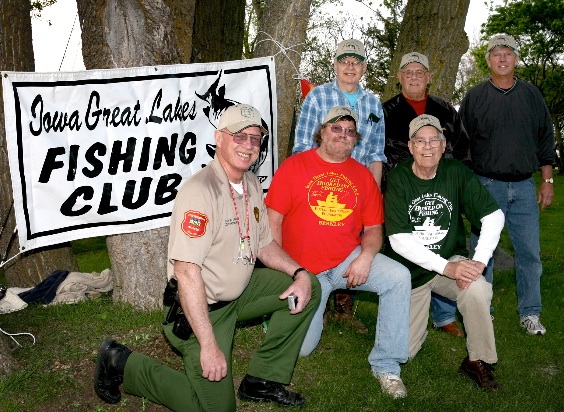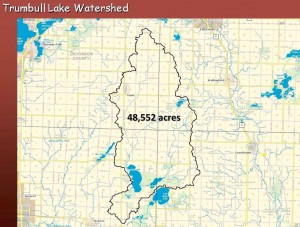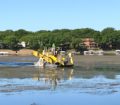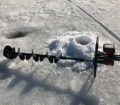By Steve Weisman
Outdoor Editor
When I first moved to northwest Iowa back in 1978, one of the lakes I would frequent, especially in the winter, was Trumbull Lake located south of Terril. The 1,200-acre lake was prime for catching jumbo perch in the winter, and during the summer, my son and I would fish it for northern pike.
At that time, Trumbull Lake was also excellent for waterfowl. However, over the years Trumbull Lake began to suffer from poor water quality and a fishery that became dominated by common carp. Waterfowl use also significantly declined.
Yet all you have to do is go back to 1916 when the State Highway Commission made this statement about Trumbull Lake. “Trumbull is a clear open body of water, five feet in depth. The beaches are covered in gravel. Fishing has always been considered good, and many big pickerel as well as quantities of smaller fish are taken during the season. The shooting is good: the outlying sloughs and sheltered bays afford both shelter and feeding places for wildfowl.”
Now, nearly 95 years later the lake was nothing but a turbid shallow water lake that offered little recreational benefit to anyone. Then this past spring, with the support of area residents, the Iowa DNR began a partial water drawdown similar to one done a few years ago at West Swan Lake located southeast of Estherville. That drawdown helped bring back aquatic vegetation along the shoreline helping improve water quality and fish and wildlife habitat at West Swan, and the goal was for that same thing to happen at Trumbull Lake. It wouldn’t take care of everything like a total drawdown would, but it would help.
Low and behold, Mother Nature took over and with the drought-like conditions, an extended drawdown occurred, making it a dry lake basin, which, according to Mike Hawkins, Iowa DNR fisheries biologist headquartering out of the Spirit Lake Hatchery, gives the stakeholders the chance to totally restore the lake. Hawkins, who has been instrumental in working on several successful shallow lake restoration projects in northwest Iowa, says Trumbull Lake was on the long range restoration plan, but the recent drought makes this the right time.
“Trumbull has an enormous watershed so we need to take advantage of this opportunity that Mother Nature is granting us to recharge the marshes and improve the lake by getting plants to return and to eliminate the carp,” noted Hawkins. The Trumbull Lake watershed includes 48,552 acres in a four county area: Clay, Emmet, Dickinson and Palo Alto counties. This is a 42 to 1 watershed to lake area ration, which is huge. With the huge watershed has come sedimentation issues. In 2012, the ISU Limnology Lab stated that 12 inches of sediment has built up on the lakebed since 1894.
Bryan Hellyer, wildlife biologist for the DNR, echoed Hawkins’ assessment. “This could be a blessing in disguise. While things didn’t go as planned with the drawdown, we now have an opportunity to reset the lake-marsh system and go from a shallow lake with murky water and no vegetation to one that benefits waterfowl, shorebirds, and all kinds of wetland wildlife with emergent and submergent vegetation. That’s exciting.”
At a public meeting held on October 23 at the Dickinson County Nature Center, Hawkins shared the vision for restoring Trumbull Lake. The restoration plans begin this coming spring. First, Hawkins noted, is the need to dig a channel in the early spring to keep the lakebed dry. This will give a greater chance for aquatic vegetation to take hold during the critical late spring period and for lake bottom compaction to occur.
“Trumbull Lake has been in a dismal state for years. It has a history of some boom and bust cycle of fishing, but mostly poor fishing and poor water quality. What this project should do is improve the water quality and make the fishery more consistent,” Hawkins said.
Water quality stats support the poor water quality statement. It all begins with an incredibly high phosphorus level that is typically more than double that of other public lakes. Phosphorus is the leading cause of algae blooms that cause very poor water clarity, which in turn leads to a lack of aquatic vegetation (which help increase water clarity). “All of the information we have shows that Trumbull Lake was a healthier lake historically,” says Hawkins. “This project should push Trumbull Lake back in the right direction. Phosphorus will get locked up in aquatic plant life instead of algae and green water.”
When all of the work is completed, Trumbull Lake will be carp-free for the first time since carp were introduced over 100 years ago. “We have eliminated all of the carp in the lake itself, and Round Lake, and we also surveyed the creek for signs of carp,” adds Hawkins.
“Even though this project has gotten a jump start, we don’t want to forget the other important parts of a health lake,” says Hawkins. “For a lake to be truly healthy, its watershed (land that drains to the lake) must be healthy.”
According to Hawkins, that takes landowners practicing good land use practices, key wetland restorations and addressing bank erosion in drainage ditches. “Most watershed work begins long before work at the lake takes place, but Mother Nature didn’t care about our schedule!” So, as the lake restoration takes place, conservation professionals from the four-county area will discuss the incentives and programs that landowners can participate in to help ensure the project’s long-term success.
The restoration plan includes allowing the lake to slowly refill beginning in June, which will allow the new vegetation to get a good start. If conditions are right, the timeline for completion looks like this. “We would like to have the water levels come up as the vegetation grows and have the lake full by late summer. Stocking yellow perch and northern pike will begin in the spring of 2014.”




















Be looking forward to see how this project developes. I’m actually surprised it wasn’t silted more than that in the last 100 years. For the sake of the lake the drought was good timing although thats the only thing good about it. Hopefully the timing will be right for the fill up and the replenishing of the earth for everyones sake.
I grew up fishing in Trumbull lake, I have caught more perch and bullheads from the shore than I care to count. Imagine my surprise when I flew back to Iowa to visit family and decided to drive my girls out to Trumbull to show them the lake I had told them so many stories about.
It was almost completely dry and I couldn’t imagine what could have happened. When we headed down to the outlet and I saw the channel that had been dug and the boards that normally held back the lake were gone I changed from sad to curious. It had been drained but why?
Now I know what happened and am very happy to hear about the restoration.
Most kids I went to school with in Spencer always wanted to head up to Okaboji for fun on the summer. Not me, Trumbull was where I liked to go. Only time it was crowed was when people were trying to catch Notherns at the outlet in the spring. The rest of the summer there was always a place to fish and hang out. I wonder how many of my fishing hooks are still hanging in the trees along the shore of that lake.
I know what you mean. When I was a kid we used to pitch a tent at the boat ramp and catch perch and pike all night. Seemed like we always had the entire lake to ourselves. Great memories.
[…] (A follow up to a previous story) […]